Crude drug sample data base
※Click on the image to enlarge it.
The capital city, provincial capital city or the representative
location of its administrative area is indicated.
location of its administrative area is indicated.
Production area information
https://ethmed.toyama-wakan.net/img/pin_san.png
33.6844202
73.04788480000002
Collection information
Islamic Republic of Pakistan,Islamabad
https://ethmed.toyama-wakan.net/img/pin_nyu.png
Scientific information data base
| Crude drug name | Urudu name, English name | Anjbar, Snake weed, Adderwort | ||||
|---|---|---|---|---|---|---|
| Arabic name / Persian name | Anjbar, Asa al-rai / Angyar, Bandak | |||||
| crude drug image |
| |||||
| Original plant name | Polygonum bistorta Linn. | |||||
| Family name | Polygonaceae | |||||
| Used part | Root | |||||
| Distribution area | From Kashmir to Sikkim and in the hills of Assam, up to 15,000 ft. It is also found in Syria and Tabristan. | |||||
| Function and properties | Excretion, Blood discharge, Respiratory organs. Astringent and digestive, tonic for stomach and intestines, antibilious, biliary sedative, febrifuge. It is constipative, too. | |||||
| Specific actions | Astringent, (antihaemorrhagic/antihemorrhagic) useful against bloody stools and dysentery, bloody discharge in leucorrhoea/leucorrhea. Useful in haemoptysis/hemoptysis and hematuria. | |||||
| Frequency in use | Wild in north-east region (limited area) of India. | |||||
| Common uses | It is consitpative, therefore, it is given to check dysentery. It is not harmful due to constipative nature. Due to styptic and antihaemorrhagic/antihemorrhagic, it is very useful against bloody discharge. The root is also used against hematuria. Also effective against tuberculosis and phthisis and relevant lung affections. It checks vomiting due to sedative property and traditionally has been used to stop haemorrhage/hemorrhage from surgical sites in body and to clean them. | |||||
| Side effect | Described as harmful (in large doses or prolonged duration) for individuals with cold temperament. | |||||
| Medical system | Unani | |||||
| Traditional concept | Temperament | It is cold and dry in the first degree. | ||||
| Drug effect | It is very beneficial for checking bloody stools and blood dysentery. Also effective against simple or chronic diarrhoea(diarrhea) / dysentery. It is regarded as safe (astringent property), therefore may be used as internal styptic against any organ where haemorrhage/hemorrhage occurs. | |||||
| Dosage | 3 to 5 gm. | |||||
| Substitute | Habb al-aas (Myrtus communis Linn.). | |||||
| Related drugs | Polygonum viviparum Linn. is also used in some areas of Northern region instead of P. bistorta Linn. The very closed species P. aviculare Linn. has also somewhat similar properties. | |||||
| Corrigent (corrective) | Zanjibeel (Zingiber officinale Rosc.) and honey pure. | |||||
| Important compound preparations | Sherbat Anjbar, Ma`jun Bawasir, Safuf Istehazah and Ma`jun Tewaj. | |||||
| References | Reference book Tips! | Glossary of Indian Medicinal Plants, 1956. Chopra, R.N., Nayar, S.L. and Chopra, I.C., Council of Scientific & Industrial Research, New Delhi. - New Edition (1996) National Institute Science Communication; Supplement pp 200-201. Makhzanul-Mufradat (Khawasul Adviyah), Hakeem Kabiruddin, Daftar Al-Masih, Qarol Bagh, Delhi. pp 93-94. Dictionary of Economic Plants in India, 1996 (2nd Rep.). Singh, U; Wadhwani, A. M. and Johri B.M. Indian council of Agricultural Research, New Delhi. p 180. Al-Jamili Mufradt Al Adwiya Wal Aghziya (1197-1248 A.D.). Ibn al-Baytar. Vols. 1-3, 1985-1999. Central council for Research in Unani Medicine, Janakpuri, New Delhi. Vol. 1, pp 138-139. Hamdard Pharmcopoeia of Eastern medicine, 1969. Said, H. M. (editor), The Times Press, Sadar Karachi. pp 173, 261. Indusyunic Medicine, 1997. Usmanghani, K., Saeed, A. and Alam, M. T. Department of Pharmacognosy, Faculty of Pharmacy, University of Karachi, Karachi. pp 354-355. Unani Adwiyah Mufradah, 1984. Ali, Saifuddin, A. (3rd edi.). Taraqi-e-Urdu Bureau, R. K. Puram, New Delhi. pp 47-48. | ||||
| Remarks | Avicenna (Ibn Sina) has not described this drug in his famous book ''The Canon of Medicine''. Ibn al-Baytar has described various attributes of this drug and according to him it is an effective drug against tuberculosis and phthisis. A patient involved in hematuria and purulent urine since ten years got relief after the use of Anjbar (Bitort root). Polygonum viviparum Linn. is also supplied in North India under the name ''Anjbr''. | |||||
| Last renewal date | 2024/02/22 | |||||





